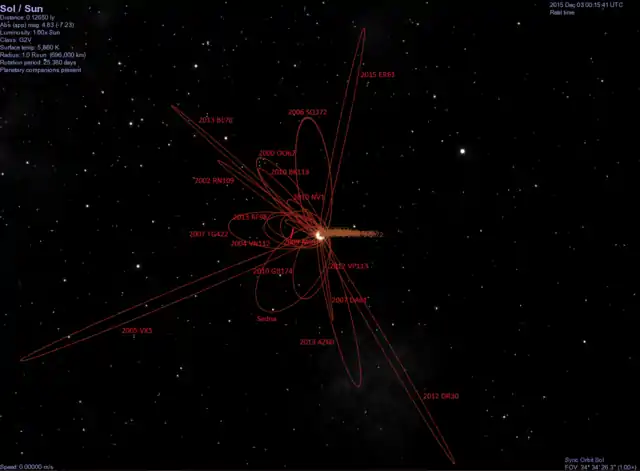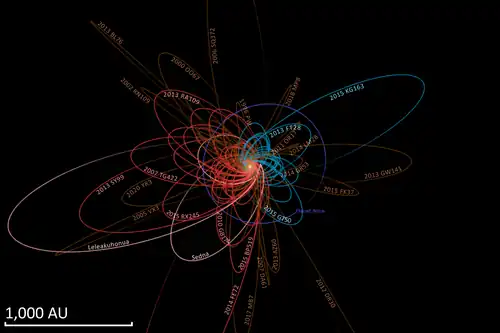2013 BL76
2013 BL76 is a trans-Neptunian object and centaur[4] from the scattered disk and Inner Oort cloud approximately 30 kilometers in diameter.
 The orbits of some of the most distant minor planets, 2013 BL76 at top left | |
| Discovery[1][2][3] | |
|---|---|
| Discovered by | Mt. Lemmon Survey |
| Discovery date | 20 January 2013 |
| Designations | |
| 2013 BL76 | |
| Orbital characteristics[1] | |
| Epoch 4 September 2017 (JD 2458000.5) | |
| Uncertainty parameter 1 | |
| Observation arc | 1.88 yr (687 days) |
| Aphelion |
|
| Perihelion | 8.3622 AU |
| |
| Eccentricity | 0.9923 |
| |
| 0.0493° | |
| 0° 0m 0s / day | |
| Inclination | 98.613° |
| 180.20° | |
| 165.96° | |
| Physical characteristics | |
| Dimensions | |
| 22.1[7] | |
| 10.8[1][5] | |
Using an epoch of February 2017, it is the minor planet with the 5th largest heliocentric semi-major axis in the Solar System (larger ones include 2014 FE72, 2012 DR30, and 2005 VX3).[8] 2013 BL76 has a barycentric semi-major axis of ~964 AU,[9][lower-alpha 1] which is the third largest barycentric semi-major axis of any minor planet.
Possible comet
With an absolute magnitude (H) of 10.8[5] and an unknown albedo, the object has an estimated diameter of 15–40 km.[6] Since it has not been seen out-gassing, it is not known if it is a comet or not. It might also be a damocloid, a type of minor planet that was originally a comet but lost most of its near-surface volatile materials after numerous orbits around the Sun. It also might be a dormant comet that simply has not been seen outgassing.
Orbit
2013 BL76 came to perihelion 8.3 AU from the Sun on 27 October 2012, when it reached an apparent magnitude of about 20.[2] In 1927, when it was 100 AU from the Sun, it had an apparent magnitude of about 30.8.[11] For comparison dwarf planet 90377 Sedna had an apparent magnitude of 21.7 when it was 100 AU from the Sun.[12] It comes to opposition at the start of September.
It will not be 50 AU from the Sun until 2045. After leaving the planetary region of the Solar System, 2013 BL76 will have a barycentric aphelion of 1920 AU with an orbital period of 29900 years.[lower-alpha 1]
The orbit of 2013 BL76 currently comes closer to Saturn than any of the other giant planets.[5] In a 10 million year integration of the orbit, the nominal (best-fit) orbit acquires a perihelion point of 0.5 AU (inside the orbit of Venus), and one of the 3-sigma clones acquires a perihelion point of only 0.008 AU (1,200,000 km).[4]
2013 BL76 travels in a technically retrograde orbit around the Sun. It is actually orbiting in a plane nearly perpendicular to that of the ecliptic. It has the 55th highest inclination of any known asteroid, after 2010 GW147 and before 2014 HS150.
Comparison

| Epoch | Barycentric Aphelion (Q) (AU) | Orbital period yr |
|---|---|---|
| 1950 | 1849 | 28300 |
| 2050 | 1920 | 29900 |
Largest semimajor axes of minor planets
| Similar bodies | |||||||||
|---|---|---|---|---|---|---|---|---|---|
| Minor planet desig. | Semi- major axis |
Semi- major axis (bary) |
Perihelion | Aphelion | Aphelion (bary) |
Abs. mag. (H) |
Diameter (km) |
Orb. uncert. (0–9)[lower-alpha 2] |
No. obs. (arc days) |
| 2002 GB32 | 213 | 206.7 | 35.3420 | 390 | 378 |
| 120 | 3 | 26 (4733) |
| (82158) 2001 FP185 | 220 | 216 | 34.2340 | 406 | 398 | 6.0 | 265 | 3 | 50 (2461) |
| 2012 KA51 | 224 | 190 | 4.9 | 444 | 380 | 11.1 | 15 | 9 | 12 (6) |
| (148209) 2000 CR105 | 229.8 | 222.2 | 44.2000 | 415.5 | 400.4 | 6.3 | 320 | 3 | 54 (3242) |
| (468861) 2013 LU28 | 230 | 230 | 8.698 | 460 | 451.5 | 7.9 | 115 | 5 | 56 (385) |
| 2006 UL321 | 261 | 257 | 23.5 | 498 | 490.5 | 7.6 | 125 | 9 | 3 (1) |
| 2012 VP113 | 265 | 263.158 | 80.4500 | 448 | 445.88 | 4.0 | 460 | 5 | 26 (739) |
| 1996 PW | 267 | 240 | 2.5557 | 532 | 480 | 14.0 | 7 | 2 | 250 (506) |
| 2011 OR17 (2010 KZ127) | 272 | 270 | 3.0987 | 550 | 540 | 13.1 | 10 | 1 | 101 (748) |
| 2013 RF98 | 320 | 316.7 | 36.288 | 603 | 597 |
| 90 | 5 | 38 (56) |
| (336756) 2010 NV1 | 322.7 | 286 | 9.41587 | 635.9 | 562 | 10.6 | 34 | 1 | 147 (1815) |
| 474640 Alicanto | 328.8 | 327.3 | 47.3324 | 610.3 | 607.3 | 6.4 | 314 | 2 | 28 (3611) |
| (418993) 2009 MS9 | 349.55 | 352.5 | 11.00317 | 688.1 | 694 |
| 42 | 1 | 134 (1995) |
| 2010 GB174 | 367 | 351.1 | 48.5600 | 686 | 653.7 | 6.5 | 223 | 3 | 18 (965) |
| 2007 DA61 | 475 | 500 | 2.6550 | 950 | 900 |
| 4.5 | 4 | 78 (29) |
| 2010 BK118 | 490 | 385 | 6.1050 | 980 | 770 | 10.2 | 38 | 1 | 292 (1319) |
| 90377 Sedna | 524.2 | 505.88 | 76.094 | 972.4 | 935.6 | 1.5 | 1000 | 2 | 90 (8819) |
| 2007 TG422 | 530 | 501.8 | 35.5830 | 1030 | 968 | 6.2 | 343 | 2 | 34 (1956) |
| (87269) 2000 OO67 | 570 | 555 | 20.7900 | 1100 | 1110 | 9.2 | 60 | 2 | 34 (2187) |
| 2002 RN109 | 720 | 850 | 2.7040 | 1440 | 1201 | 15.3 | 4 | 3 | 38 (80) |
| (308933) 2006 SQ372 | 765 | 792 | 24.172 | 1500 | 1585 | 8.1 | 110 | 2 | 65 (1830) |
| 2013 AZ60 | 880 | 593 | 7.908 | 1700 | 1176 | 10.2 | 62.3 | 1 | 189 (8067) |
| 2013 BL76 | 1251 | 940 | 8.37358 | 2494 | 1825 | 10.8 | 35 | 1 | 68 (687) |
| 2012 DR30 (2009 FW54) | 1300 | 1036 | 14.546 | 2600 | 2030 | 7.1 | 171 | 0 | 206 (5375) |
| 2005 VX3 | 1300 | 1200 | 4.133 | 2700 | 2038 | 14.1 | 6 | 4 | 50 (81) |
| 2014 FE72 | 2000 | 1500 | 36.3 | 4000 | 3000 | 6.0789±0.1699 | 226 | 5 | 12 (623) |
Notes
- Given the orbital eccentricity of this object, different epochs can generate quite different heliocentric unperturbed two-body best-fit solutions to the semi-major axis and orbital period. For objects at such high eccentricity, the Sun's barycenter is more stable than a heliocentric solution.[10] Using JPL Horizons, the barycentric semi-major axis is approximately 964 AU.[9]
- 0–3 is high-certainty and well constrained, 9 is low-certainty and probably lost.
References
- "JPL Small-Body Database Browser: (2013 BL76)" (last observation: 2014-08-25; arc: 1.88 years). Jet Propulsion Laboratory. Archived from the original on 4 January 2014. Retrieved 25 March 2016.
- "2013 BL76". Seicchi Yoshida's Home Page. Archived from the original on 15 January 2020. Retrieved 12 July 2013.
- "MPEC 2013-C12 : 2013 BL76". IAU Minor Planet Center. 3 February 2013. Retrieved 14 October 2013. (K13B76L)
- Marc W. Buie. "Orbit Fit and Astrometric record for 13BL76". SwRI (Space Science Department). Archived from the original on 6 February 2016. Retrieved 3 February 2016.
- "2013 BL76". IAU minor planet center. Archived from the original on 12 July 2013. Retrieved 12 July 2013.
- "Absolute Magnitude (H)". NASA/JPL. Archived from the original on 2 March 2001. Retrieved 13 October 2013.
- "AstDyS 2013BL76 Ephemerides". Department of Mathematics, University of Pisa, Italy. Retrieved 4 February 2016.
- "JPL Small-Body Database Search Engine: Asteroids and a > 100 (AU)". JPL Solar System Dynamics. Archived from the original on 6 March 2014. Retrieved 13 October 2013. (Epoch defined at will change every 6 months or so)
- Horizons output. "Barycentric Osculating Orbital Elements for 2013 BL76". Retrieved 6 March 2014. (Solution using the Solar System Barycenter and barycentric coordinates. Select Ephemeris Type:Elements and Center:@0)
- Kaib, Nathan A.; Becker, Andrew C.; Jones, R. Lynne; Puckett, Andrew W.; Bizyaev, Dmitry; Dilday, Benjamin; Frieman, Joshua A.; Oravetz, Daniel J.; Pan, Kaike; Quinn, Thomas; Schneider, Donald P.; Watters, Shannon (2009). "2006 SQ372: A Likely Long-Period Comet from the Inner Oort Cloud". The Astrophysical Journal. 695 (1): 268–275. arXiv:0901.1690. Bibcode:2009ApJ...695..268K. doi:10.1088/0004-637X/695/1/268. S2CID 16987581.
- "AstDys 2013BL76 Ephemerides for 1927 (when 100AU from Sun)". Department of Mathematics, University of Pisa, Italy. Retrieved 14 October 2013.
- "AstDys (90377) Sedna Ephemerides for 1975 (when 100AU from Sun)". Department of Mathematics, University of Pisa, Italy. Retrieved 14 October 2013.
External links
- Webcite archive of Epoch 2015-06-27 with aphelion (Q) of 2467 AU
- 2013 BL76 at AstDyS-2, Asteroids—Dynamic Site
- 2013 BL76 at the JPL Small-Body Database